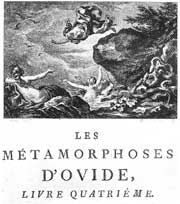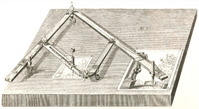
 |
 |
 A pantograph used for illustration taken from Diderot's Encyclopedia. |
 See wood type cut using a pantograph at the Hamilton Wood Type Museum. Turn down your volume control first!) See wood type cut using a pantograph at the Hamilton Wood Type Museum. Turn down your volume control first!) |
25. Metal Engraving/ The refined lines of the images printed from metal plates were lighter than those from wood blocks and consequently needed to be balanced against lighter type faces. |
26. Alois Senefelder, 1798 The advantage of lithography was that letters were hand drawn, allowing for all sorts of curves and formations that metal did not allow. The sampling of letters shown above were drawn by Henri Van de Velde in the late 19th century, drawn as therapy as he recovered from a nervous breakdown. The inventor of this process was Alois Senefelder, an actor/playwright who wanted to print the playbill for his new production. He experimented with an etching technique using a greasy, acid resistant ink as a resist on a smooth fine-grained stone of Solnhofen limestone. All type had to be written in reverse but it was usually transferred from a right reading image.
|
27. The Pantograph, The pantograph was a device used to make an enlarged or reduced size copy of an image by means of tracing the original. It worked by a system of hinged levers equipped with a tracing point and a writing device. Although the example shown is for copying illustrations, the device also had applications for copying and cutting type. The technology to trace letters from a master meant that the punchcutter's skills, although not their expertise, was made obsolete. See what the pantograph meant to the art of punchcutting by reading the interview of Mathew Carter at ?????? |
28. Wooden Type Metal type casting was limited to a few inches in height due to difficulties of casting larger type, the weight and the cost. Wood, however, had been was used for lettering and illustrations dating back to the first printed documents in China in 868. In 1827 Darius Wells invented the lateral router, a saw that could cut curved outlines in wood allowing for the production of a lighter, larger and cheaper letterform. ĺ─˙The usual procedure was to draw the letter on wood, or paper, which was pasted to wood. Then cut around the letter with a knife or graver, gouging out the parts to be left blank. Wells, however introduced a basic invention, the lateral router that, in combination with a pantograph constitutes the essential material for mass produced wood type.ĺ─¨ |